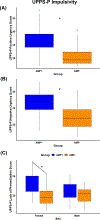Impulsivity in amphetamine use disorder: Examination of sex differences
- PMID: 37132044
- PMCID: PMC10524483
- DOI: 10.1111/add.16225
Impulsivity in amphetamine use disorder: Examination of sex differences
Abstract
Aims: This study aimed to test whether there are sex differences in the relationship between impulsivity and amphetamine use disorder (AMP).
Design: A naturalistic cross-sectional design was used.
Setting: The Tulsa 1000 study was held in Tulsa, OK, USA.
Participants: There were two groups in this study: AMP+ (29F, 20M) and AMP- (57F, 33M).
Measurements: This project focuses on data related to impulsivity: UPPS-P impulsive behavior scale and a stop signal task (SST) during functional magnetic resonance imaging (fMRI) recording. Group, sex and their interaction were compared for UPPS-P ratings and SST fMRI and behavioral responses.
Findings: AMP+ reported higher UPPS-P positive and negative urgency scores (Ps < 0.001; r = 0.56 and 0.51) and displayed greater bilateral insula and amygdala responses across correct SST trials (Ps < 0.001, g range = 0.57-0.81) than AMP-. fMRI results indicated that AMP+ exhibited larger right anterior/middle insula, amygdala and nucleus accumbens signals during successful difficult stop trials than AMP- (Ps < 0.01; g = 0.63, 0.54 and 0.44, respectively). Crucially, two group × sex effects emerged: (a) within females, AMP+ reported larger UPPS-P lack of premeditation scores than AMP- (P < 0.001, r = 0.51), and (b) within males, AMP+ showed greater left middle insula signals than AMP- across correct SST trials (P = 0.01, g = 0.78).
Conclusions: Both female and male amphetamine users appear to be characterized by rash action in the presence of positive and negative mood states as well as heightened recruitment of right hemisphere regions during behavioral inhibition. In contrast, planning ahead may be particularly difficult for female amphetamine users, whereas male amphetamine users may need to recruit additional left hemisphere resources during inhibitory processing.
Keywords: Amphetamine use disorder; behavioral inhibition; functional magnetic resonance imaging; impulsivity; negative urgency; positive urgency; sex differences.
© 2023 Society for the Study of Addiction.
Conflict of interest statement
Figures






Similar articles
-
Parsing impulsivity in individuals with anxiety and depression who use Cannabis.Drug Alcohol Depend. 2020 Dec 1;217:108289. doi: 10.1016/j.drugalcdep.2020.108289. Epub 2020 Sep 16. Drug Alcohol Depend. 2020. PMID: 33002704 Free PMC article. Clinical Trial.
-
Response inhibition and its relation to multidimensional impulsivity.Neuroimage. 2014 Dec;103:241-248. doi: 10.1016/j.neuroimage.2014.09.021. Epub 2014 Sep 18. Neuroimage. 2014. PMID: 25241087
-
Is gambling disorder associated with impulsivity traits measured by the UPPS-P and is this association moderated by sex and age?Compr Psychiatry. 2017 Jan;72:106-113. doi: 10.1016/j.comppsych.2016.10.005. Epub 2016 Oct 11. Compr Psychiatry. 2017. PMID: 27810546
-
Impulsivity related personality traits and cigarette smoking in adults: A meta-analysis using the UPPS-P model of impulsivity and reward sensitivity.Drug Alcohol Depend. 2018 Apr 1;185:149-167. doi: 10.1016/j.drugalcdep.2018.01.003. Epub 2018 Feb 9. Drug Alcohol Depend. 2018. PMID: 29453142 Review.
-
Parsing the heterogeneity of impulsivity: A meta-analytic review of the behavioral implications of the UPPS for psychopathology.Psychol Assess. 2015 Dec;27(4):1129-46. doi: 10.1037/pas0000111. Epub 2015 Mar 30. Psychol Assess. 2015. PMID: 25822833 Review.
Cited by
-
Computational mechanisms underlying multi-step planning deficits in methamphetamine use disorder.Transl Psychiatry. 2025 May 24;15(1):181. doi: 10.1038/s41398-025-03390-8. Transl Psychiatry. 2025. PMID: 40413170 Free PMC article.
-
Computational Mechanisms Underlying Multi-Step Planning Deficits in Methamphetamine Use Disorder.medRxiv [Preprint]. 2024 Jun 28:2024.06.27.24309581. doi: 10.1101/2024.06.27.24309581. medRxiv. 2024. Update in: Transl Psychiatry. 2025 May 24;15(1):181. doi: 10.1038/s41398-025-03390-8. PMID: 38978681 Free PMC article. Updated. Preprint.
References
Publication types
MeSH terms
Substances
Grants and funding
LinkOut - more resources
Full Text Sources
Medical

